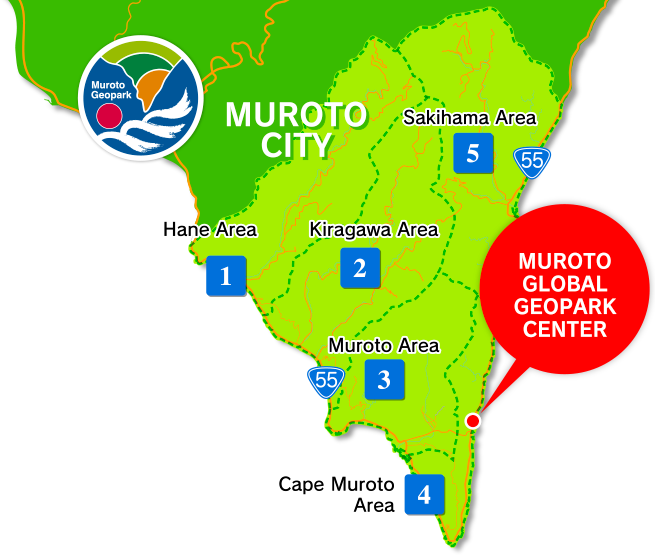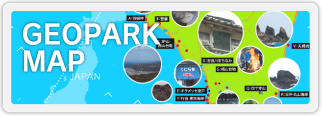

The western gateway to Muroto UNESCO Global Geopark. The turbidites that jut up here were formed by layers of sandstone and mudstone on the bottom of the sea, and pushed up onto land by tectonic activity. To walk along the coastline at Cape Hane is to walk upon the ancient sea floor. You can still see traces in the rocks of the currents and the creatures that lived there. Local fishermen come to the shrine at Cape Hane to pray for safety before they head out to sea.
-

The marine terraces around Hane and Kiragawa offer panoramic views of the sea and plateaus. In places over 100 meters above sea level, you can find pebbles smoothed by the waves when the terraces used to be part of the coastline, showing that Muroto really is on the rise!
-

Watermelons, eggplant, sweet potatoes, loquats, citrus and much more are grown on the marine terraces. They are treasures of the geopark. You can even take part in farming experiences here, while the wide, blue Pacific stretches out before you.
-

Bring your magnifying glass to the Nobori formation site to find fossils and traces of the small creatures that lived on the sea floor up to 3-4 million years ago, or maybe even a shark tooth! (Please note that permission for entry is required.)
-

Kagamio Shrine deifies Okamura Jubei, a warrior who saved the people when they were in need, by taking rice from the old domain administration and delivering it to those in need. He then took his own life, but his deed have not been forgotten.

The traditional design of Kiragawa’s townhouses and stone walls give the feeling of a vibrant regional community, and a taste of the scenery characteristic of old rural towns in Kochi Prefecture. This is why Kiragawa has been designated as an Important Preservation Districts for Groups of Traditional Buildings by the national government. It is a representative example of the geopark experience: a place where you can see and experience the deep bonds between nature, culture and industry.
-

Kiragawa prospered in the past as a distribution center for high-quality charcoal. You can still find 37 kilns in Muroto producing Tosa Binchotan charcoal. At certain times, there are charcoal burning experiences on offer.
-

The Onda Festival, held biannually in May at the Kiragawa Hachiman Shine has been going on since the12th century and has been designated as an Important Intangible Folk Cultural Properties. The shrine grounds are also a lovely place for a stroll when wild festivals are not being held there!
-

Kiramesse Muroto features an information center, a whale museum where you can find out about Muroto’s historical whaling culture, a local produce market selling fruit grown on the marine terraces and a restaurant serving local cuisine that uses this produce.
-

The geological heritage of Muroto Geopark is on full display along the Gyodo-Kuromi coastline. Here you can see turbidites, trace fossils, sand dykes and rocks warped by underwater landslides and rippled by underwater currents.

This central area of Muroto City is full of experiences and sites where you can connect with Muroto’s diverse heritage. Three temples of the Shikoku Pilgrimage are situated around the Muroto area: Kongocho-ji in the west, Shinsho-ji by the Murotsu port and Hotsumisaki-ji above Cape Muroto. Umi no Eki Toromu is the end of the line for the bus from Osaka and a base for transport. Here you will find a restaurant and a store selling local produce and souvenirs.
-

The geography of Murotsu Port is a witness to the rising of the Muroto Peninsula. It is also the busiest area of Muroto, and a great place to experience local cuisine and learn about Muroto’s whale culture, where the role of caught whales in local life was honored.
-

Narashi-Moto Beach is a beautiful stretch of coastline where sea turtles come to lay their eggs in the sand. The children from the local elementary school incubate these eggs and release the baby turtles into the sea. You can also find rocks on this beach that contain whale fossils.
-

The straight stretch of the Sakamoto coast is lined with bright red hibiscus and a number of inns. The coast shines beneath the brilliant sun. If you are driving through, stop for a moment and experience its beautiful scenery for yourself. It is a perfect place for walking or cycling.
-

Mt. Shijuji is the signature mountain of Muroto, offering a great view of the city. There is a small temple at the top of the mountain. Mt. Shijuji has been a site of worship since long ago. The mountain path is maintained and relatively gentle, allowing for a comfortable hike.

Cape Muroto is a site with more geospots than anywhere else in Muroto UNESCO Global Geopark. There are evidences of uplift, jizo statues, the seven mysteries of the monk Kukai and much more. Wherever you look, there is something new to see here. And there are guides to show you around. While looking at the courses available, you can also enjoy making your own course through the many sites of the cape.
-

At the cape you can observe coastal and subtropical vegetation adapted to Muroto’s strong sea breezes and mild climate. Here you can enjoy the diverse colors of the seasonal flowers and the interesting plants designated as a natural monument by the national government.
-

Cape Muroto is a rare place where you are able to observe both a daruma sunrise and a daruma sunset. These are mirages that occur when the sun is close to the horizon, and looks like a traditional Japanese daruma doll is poking its head over the sea horizon.
-

Mikurado Caves were formed at sea level, by waves eroding a great hole into the cliffs. They are most well known as the place where the Buddhist monk Kukai is said to have practiced asceticism and achieved enlightenment. You can experience a beautiful vista of the sea and the sky when looking out from the cave.
-

Cape Muroto is rising. You can see the power of the earth and the birth of new land here in the diverse rock formations, such as the large turbidites, which were formed on the sea floor, and twisted and pushed to the surface of the water at the tip of the cape.

Sakihama was a town that prospered as a producer of lumber and high-quality Tosa Binchotan charcoal. The lumber cut down in the mountains was sent down Sakihama river and collected at the coast, where the proximity to Osaka made for a thriving business. A traditional play called Niwaka, a kind of satire, is performed here, and has been designated as an Intangible Cultural Property by the national government. It is performed every year at the autumn festival.
-

At Mt. Dannotani you can view ancient cedars, massive and gnarled, while the Kanagi landslide site is a testament to the people of Sakihama, who worked for almost fifty years restoring the mountains to stop the frequent landslides that used to bury Sakihama with sediment.
-

At Hioki fishing port, on the Hioki-Maruyama Coast, there is a huge basalt rock in the sea. It used to be magma that erupted from the sea floor and was cooled by the water. This process leads to the distinctive shape of the rock, with the many lumps on its surface known as “pillow lava.”
-

Muroto is able to harvest deep seawater because of the steep cliff off its east coast, that drops down to a depth of 1000m below sea level. At the Aqua Farm you can find out all about this water, how it is harvested and its use in industries such as farming and seaweed cultivation.
-

Searest Muroto is a facility where you can experience deep seawater for yourself, relaxing in its heated pool while looking out over the Pacific, while the nearby resort hotel UTOCO has a spa and a beauty salon that both utilize deep sea water.





